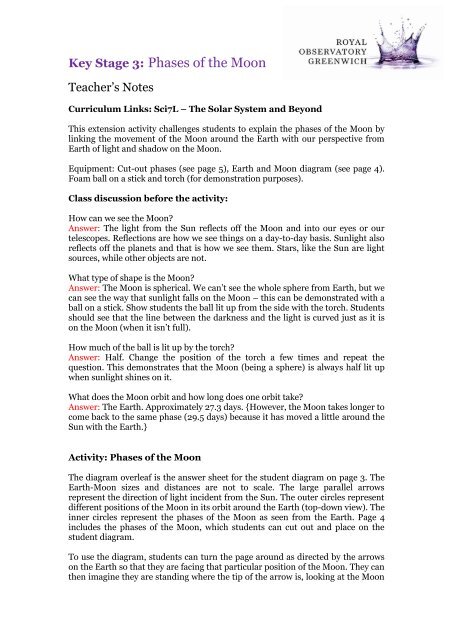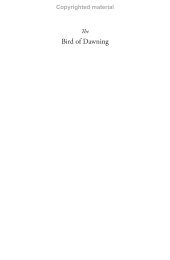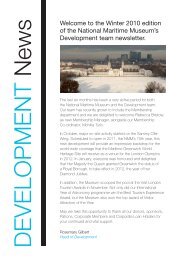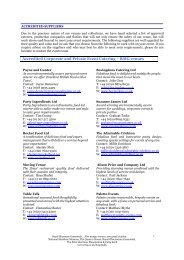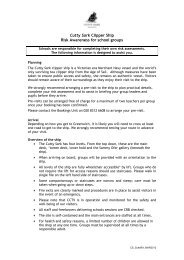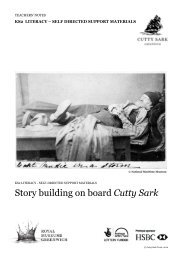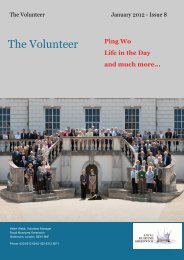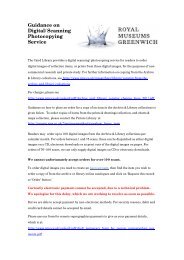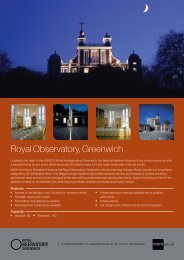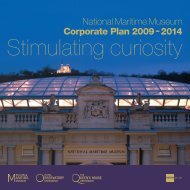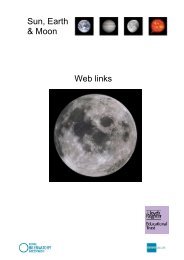You also want an ePaper? Increase the reach of your titles
YUMPU automatically turns print PDFs into web optimized ePapers that Google loves.
Key Stage 3: <strong>Phases</strong> <strong>of</strong> <strong>the</strong> <strong>Moon</strong><br />
Teacher’s Notes<br />
Curriculum Links: Sci7L – The Solar System and Beyond<br />
This extension activity challenges students to explain <strong>the</strong> phases <strong>of</strong> <strong>the</strong> <strong>Moon</strong> by<br />
linking <strong>the</strong> movement <strong>of</strong> <strong>the</strong> <strong>Moon</strong> around <strong>the</strong> Earth with our perspective from<br />
Earth <strong>of</strong> light and shadow on <strong>the</strong> <strong>Moon</strong>.<br />
Equipment: Cut-out phases (see page 5), Earth and <strong>Moon</strong> diagram (see page 4).<br />
Foam ball on a stick and torch (for demonstration purposes).<br />
Class discussion before <strong>the</strong> activity:<br />
How can we see <strong>the</strong> <strong>Moon</strong>?<br />
Answer: The light from <strong>the</strong> Sun reflects <strong>of</strong>f <strong>the</strong> <strong>Moon</strong> and into our eyes or our<br />
telescopes. Reflections are how we see things on a day-to-day basis. Sunlight also<br />
reflects <strong>of</strong>f <strong>the</strong> planets and that is how we see <strong>the</strong>m. Stars, like <strong>the</strong> Sun are light<br />
sources, while o<strong>the</strong>r objects are not.<br />
What type <strong>of</strong> shape is <strong>the</strong> <strong>Moon</strong>?<br />
Answer: The <strong>Moon</strong> is spherical. We can’t see <strong>the</strong> whole sphere from Earth, but we<br />
can see <strong>the</strong> way that sunlight falls on <strong>the</strong> <strong>Moon</strong> – this can be demonstrated with a<br />
ball on a stick. Show students <strong>the</strong> ball lit up from <strong>the</strong> side with <strong>the</strong> torch. Students<br />
should see that <strong>the</strong> line between <strong>the</strong> darkness and <strong>the</strong> light is curved just as it is<br />
on <strong>the</strong> <strong>Moon</strong> (when it isn’t full).<br />
How much <strong>of</strong> <strong>the</strong> ball is lit up by <strong>the</strong> torch?<br />
Answer: Half. Change <strong>the</strong> position <strong>of</strong> <strong>the</strong> torch a few times and repeat <strong>the</strong><br />
question. This demonstrates that <strong>the</strong> <strong>Moon</strong> (being a sphere) is always half lit up<br />
when sunlight shines on it.<br />
What does <strong>the</strong> <strong>Moon</strong> orbit and how long does one orbit take?<br />
Answer: The Earth. Approximately 27.3 days. {However, <strong>the</strong> <strong>Moon</strong> takes longer to<br />
come back to <strong>the</strong> same phase (29.5 days) because it has moved a little around <strong>the</strong><br />
Sun with <strong>the</strong> Earth.}<br />
Activity: <strong>Phases</strong> <strong>of</strong> <strong>the</strong> <strong>Moon</strong><br />
The diagram overleaf is <strong>the</strong> answer sheet for <strong>the</strong> student diagram on page 3. The<br />
Earth-<strong>Moon</strong> sizes and distances are not to scale. The large parallel arrows<br />
represent <strong>the</strong> direction <strong>of</strong> light incident from <strong>the</strong> Sun. The outer circles represent<br />
different positions <strong>of</strong> <strong>the</strong> <strong>Moon</strong> in its orbit around <strong>the</strong> Earth (top-down view). The<br />
inner circles represent <strong>the</strong> phases <strong>of</strong> <strong>the</strong> <strong>Moon</strong> as seen from <strong>the</strong> Earth. Page 4<br />
includes <strong>the</strong> phases <strong>of</strong> <strong>the</strong> <strong>Moon</strong>, which students can cut out and place on <strong>the</strong><br />
student diagram.<br />
To use <strong>the</strong> diagram, students can turn <strong>the</strong> page around as directed by <strong>the</strong> arrows<br />
on <strong>the</strong> Earth so that <strong>the</strong>y are facing that particular position <strong>of</strong> <strong>the</strong> <strong>Moon</strong>. They can<br />
<strong>the</strong>n imagine <strong>the</strong>y are standing where <strong>the</strong> tip <strong>of</strong> <strong>the</strong> arrow is, looking at <strong>the</strong> <strong>Moon</strong>
and work out what <strong>the</strong> face <strong>of</strong> <strong>the</strong> <strong>Moon</strong> would look like. Students can be eased in<br />
by first attempting to identify where <strong>the</strong> full moon and new moon phases should<br />
go and <strong>the</strong>n attempting <strong>the</strong> quarter phases, followed by <strong>the</strong> more difficult crescent<br />
and gibbous phases. The distances and sizes on diagrams are not to scale.<br />
When students have placed <strong>the</strong> correct phases beside <strong>the</strong> <strong>Moon</strong> positions <strong>the</strong><br />
activity can be concluded with <strong>the</strong> “match <strong>the</strong> phase name to <strong>the</strong> picture” section<br />
beneath <strong>the</strong> cut-out phases.<br />
New <strong>Moon</strong><br />
Waxing<br />
Crescent<br />
Waning<br />
Crescent<br />
First<br />
Quarter<br />
Last<br />
Quarter<br />
Waxing<br />
Gibbous<br />
Waning<br />
Gibbous<br />
Full <strong>Moon</strong><br />
2


